Z: Steel Soldiers

| a game by | Bitmap Brothers |
| Platform: | PC (2001) |
| User Rating: | 8.5/10 - 4 votes |
| Rate this game: | |
| See also: | Best RTS Games |
It's amazing what an insular world adolescence is. Maybe it was just me, bur at the age of 13, I unswervingly thought Britain was the centre of the games industry. After all, we made the best computers (Spectrum, BBC, Dragon 32 - actually scratch that last one, it ran on coal and was rubbish), and the finest games in Christendom (AticAtac, Starquake, Elite - the list is endless). Years later and, thankfully, though our collective skills at soldering transistors to rubber keyboards may have waned, British games are still some of the most innovative and engrossing titles you can buy and the Bitmap Brothers, along with Bullfrog, Ultimate Play The Game (now Rare) and individuals like Molyneux, McLean and Crammond, have constantly proved their worth time and time again. In fact, they haven't really had a duffer yet and having played a couple of levels of an early build of Z: Steel Soldiers, it doesn't look like they're about to start now.
But it has been a while since the Bitmaps released a game on PC. In fact, their last was the original Z, a one-time PC Classic that remarkably, still remains very playable if you like a serious challenge and if you can get the damn thing to work on today's ultra-fast machines.
'The guys in the office still play it, both in single and multiplayer," smiles head Bitmap Mike Montgomery, as he sips his tea. "But then I would say that, wouldn't 1?" And a good thing, too, for under the 3D-accelerated graphics Steel Soldiers retains the same simple ideals that have characterised every Bitmap game since Xenon was released in 1988. It all comes down to gameplay, really, and the original Z had it in spades. By default Z2, (recently renamed Z: Steel Soldiers) should be equally laden with anarchic fun. The rechristening, by the way, was because of trademarks: car bores will know that BMW have some four-wheeled conveyance called a Z3 which, although rather good for getting the shopping home, kind of kills off all hope of any subsequent Z sequel - or at least it did.
"You wouldn't believe the heartache we've been through finding a new name," says Mike. "It's just been unbelievable. Everyone in the office had their own ideas that they liked and it got to the point where you just think, 'fucking hell, let's just stick a pin in the wall and see what comes out'. Steel Soldiers stuck out for me when we got down to the last five names, because it represents what the game is about. Robots. Made of steel. Or something."
Changing Direction
Up until recently, names have been die least of the Bitmaps worries. The four years Z2 - sorry, Steel Soldiers - spent in development prove that it hasn't been an easy lieu ride. Taking an outside view, and this from someone who spent many hours indoors playing Speedball when, at 18, Ishould have been swallowing them, the Bitmaps four-year hiatus from gaming's fickle limelight has been far too long. "Originally, when we first started, we were quite productive," says Mike.
"The problem is that nowadays it costs a lot more money and you have to put more effort into a game and certainly, to do a game up to the quality of the Bitmap Brothers is expensive and it takes time. We always wanted to make things perfect, so we've spent a lot of time on Steel Soldiers, maybe too much time. But on this particular product we have made some brave moves, and 10 months ago we actually changed direction in a big way. It was like, 'shit, we've spent three years on this game and it's not really what we originally wanted.' It was a brave step for us to change direction slightly and, although we lost a little bit of time, it was the best thing we could have done and we've ended up with what we think is brilliant."
Jamie Barber is the one who knows the real ins-and-outs of Steel Soldiers. Lead Designer on the game from its conception, he has made it his mission to play every real-time strategy game since time began. From his not unpleasant research, one factor has been at the forefront of the Bitmap ideal - simplicity.
"The territory model is very simple, in fact, it's as simple as you could possibly get. It was slightly more complicated than it is and after a few quick decisions we changed it, tried it and everybody loved it. We streamlined the whole game, cut everything back and the game has become so simple, so intuitive -which is exactly what we were aiming to achieve, but we overcomplicated things in development by putting in things that we didn't need.
By going back to grass roots, all of a sudden we got the game that we wanted - a fast-action wargame." Of course, the biggest change from the original Z is that Mike and his micro-mechanics have had to create a 3D engine from scratch. Significantly, as with Westwood's recently announced Dune sequel, Battle For Dune, Steel Soldiers will be the Bitmaps first full 3D game and as Westwood has repeatedly professed, it's not a step to be taken lightly for a company who've yet to dissappoint its fans. Mentioning Westwood and -- the Bitmaps in the same sentence, however, is not a clever thing to do.
"Z was classed as a Command & Conquer clone," says Mike, almost as if the comparisons still wound him. "It wasn't anything like C&C, they are two completely different products. I wouldn't even say they were in the same genre, or if they are, they are at two extreme ends. That was a shame because Z was more arcade strategy', almost as if you could keep putting coins in and keep playing and playing and if you stopped for a second, you lost."
"With Steel Soldiers we've kept some of that, the simple ideas and arcade-action style of gameplay.
But what we've got now is a very advanced A1 system in there well we think it's very advanced. The AI only uses line-of-sight, it doesn't cheat... much, no it doesn't cheat. Well, it does a bit..."
Intelligent Service
The Bitmap Brothers have never been ones to mess about. In that it's played in real-time and requires strategic thought, Z: Steel Soldiers, like it's predecessor, is a real-time strategy game. Using such broad terms, however, paints the wrong picture of a game that if it were a first-person shooter, would be closer to Quake than Half-Life - a fast-paced strategy deathmatch if you will, that promises to pi equally well offline and on.
"Every time you play it's that little bit different," gushes Mike. "We spent a whole year putting scripts into the game, then we finished the AI system and thought, 'shit, we can take all these scripts out - well, 95 per cent of them'. We had to keep a few in there to set the AI up, maybe give the AI some initial objectives to wake the player up. You know, like 'come on, bloody do something'. You can't just sit there, if you do you're going to die. It's put right in your face.
"From then on it makes decisions on what you are doing, as if you and I were playing a multiplayer game. You try a new tactic and the AI reacts to what you do. The other day we noticed the AI sent out a scout helicopter, he's never done that before." "It's scary when that happens," says Jamie, nodding. "You can have robots in a bunker and sometimes, though not all the time, when you're firing at it with a couple of long-range units, just as it's about to blow, the enemy flood out and annihilate you. That unpredictability adds to the game so much."
It's a more realistic approach to gameplay. Rather than having their game in a real-world environment that will set Steel Soldiers apart and rather than crowbar in new features to list on the back of the box, it seems that less most definitely more. As with the original Z, there is no fog of war in the game, when you start the game you can pan and zoom across the entire level. You can see the boundaries between each territory, where the flag capture points are and take a guess at where your enemy might first appear by just looking over the terrain rather than having to attempt the level again and again.
In Z: Steel Soldiers, unlike almost every other strategy game, you can't blame defeat on not knowing the level, only on your tactical incompetence.
"You just have to go out there," Mike points out. "You take the flag, the flag gives you the territory, the size of the territory gives you an amount of credits and as along as you have one territory, you can get credits and can always build something - and that is it. It's as simple as that. You don't have to go and build a robot, who has to build a cart, which has to go out and collect the rubbish from the rubbish bins. It's just very simple. The resource comes from taking territory. In Steel Soldiers, you just have to take the map."
"If you've got a radar net it will show you the positions of the enemy units," Jamie adds. "But you will only physically see units if you have a line of sight to them, if you've got spotters on top of hills or units moving around nearby."
"We did have unit facing in there as well," Mike explains, "where line of sight was dependant also on which way the units were looking, but it was unplayable and boring.
It doesn't work in a fast-paced action game like Steel Soldiers. All through development we've tried things out before dismissing them. Just recently we had fire trucks in, but it spoilt the experience of the game and they just didn't fit in, so we thought 'sod it, take 'em out'. We've done that with quite a few things.
Funny Ha-Ha
One thing that has been left in and perhaps one of the many factors that sets Z apart from its contemporaries was the humour. Z centred on two robots, Brad and Alan, incompetent droids that starred in numerous cut-scenes. In this sequel both have been marooned, court-martialed and this time around take a more active part in the main game. Back, too, is Zod, the cybernetic general based on Robert Duvall's napalm-loving character from Apocalypse Now (you may have noticed him on the cover). "There's more of a story, which we didn't have before. It's more plot-driven and focused," Mike stresses. "It's also a bit darker this time around, less slapstick. But the humour still comes through with the exploits of the main characters - Brad, Alan and General Zod.
'I went to the sound recordings for the mission briefings and I was in stitches. We actually have the same voice actors that we had before, so we have continuity and these guys really are hilarious. Brad and Alan are actually the names of the two voice actors, and after we played them a few cut-scenes from the first game, they snapped back into character in seconds.
The new voice actor, Pete, worked on Phantom Menace and previous Star Wars films as well, so in voice acting circles we've got the best. But they thought it was the hardest work they'd done for months. They were losing their voice at one point."
'While we were doing the recording," Jamie remembers, laughing. "I went for a slash and Brad came in to get some water to take some paracetamol with because he had a sore throat. And while I was standing there doing my business, he suddenly turned round and, in (robot) Brad's voice, shouted: 'Atten-shun!' How I didn't piss down my trouser leg, I'll never know. He really scared the shit out of me, the bastard."
Time To Play
After being lead through a few nearly-completed missions by Jamie, it was then time for me to dive in. To say the game is a bit pacey would be something of an understatement, but having played through all of the 'big' strategy games of last year, of which Ground Control is perhaps the closest in nature, what stuck me was the movement on screen and the clean way in which everything is displayed.
The terrain may not be the most realistic interpretation of what you might find on an alien planet, but it all goes back to gameplay. Everything is immediately in view. Units don't get obscured by trees, you don't get massive status bars clogging up the screen (something that really gets my goat) and every unit sits well on the undulating terrain.
Tanks don't float or sink into the landscape as they often do with so many other games. In fact, each unit moves pretty much as you would expect. Jeeps skid over the flats and arc over hills rather than take straight lines and turn on the spot and the robots themselves are animated to the point that in formation they move as individuals. If it wasn't for the fact that to do so wouldn't get you very far, you could probably sit there for hours watching and listening to the metal carnage that follows. Unfortunately, though, I didn't have time to get used to the interface (I had to plead to even play anything after level one), and by the time I managed to get a grip on the game, the damn thing went and crashed.
"We haven't optimised the code yet," says Mike, as the PC flicks back to life. "In fact, we haven't done any optimisation for a year. Plus this PC we're playing on was dropped on the floor a little while back and we just flung all the bits back together. It's amazing it works at all. Maybe we should have done this on my machine"
"For the interface, though our brief to the designers and programmers has been 'I don't want to press a key, I don't actually mind if you put the key stuff in there, that's fine.' Some people like those things, but I don't.
Therefore, you can play the whole game without touching a key, everything is controlled by the mouse. It's very easy. Same thing with the status bar. It's there if you want it, but you can move it, minimise it or keep it to the default set-up. Even though the camera angles are restricted, you can still go to the options screen and change things so you can zoom further, swing faster, whatever. Basically, we've made things simple. But for those who like keyboard-shortcuts and completely free cameras, you can do all that as well."
The End Is Nigh
Outside their Wapping headquarters die rain clawed its way down the windows and the sun was sinking rapidly. Just back from a gruelling press trip across the US, the team were looking forward to an uncharacteristidy quiet Christmas. Before then, however, there was still much to do. Few missions were complete, though most weren't far off, the cut-scenes and a few voices had to be added and then came the messy business of tweaking and testing the game on every possible machine they could lay their hands on. Come February, the end will be in sight.
"It's been a long four years," says Jamie, looking back. "I spent ages researching into units. We played every RTS we could find, I spoke to friends and to online RTS fans - this was about the time of StarCraft, where RTS games had multiple races in, and although it's something we don't really agree with, it worked so well in StarCraft that we were going to have four races in Steel Soldiers. We didn't, though, not because of balancing issues, but because with all the best strategy games: chess, backgammon, draughts, the sides are equal and that's what makes W them so playable.
We've got 30 different units and 20 buildings, which is a fair selection. We wanted the importance to be on the individual units, their worth and balance and the combination between them. If you know what units you have, you know what you're up against. Because we've got just two sides, both with the same units, we've been able to put all our time into balancing them.
"With the single-player campaign we have 30 levels, broken into stages of five levels set across six environments. Thing is, we didn't want to do six types of terrain that were all basically the same but in different colours, so we have different terrain effects and lighting, vehicles may work better on one terrain than on another. Also, each terrain will have its own eco-system, with little creatures running around.
So each set of five maps will have a distinctive style." "There are loads of neat things," adds Mike. "For instance, in one level the enemy start off with a couple of medium tanks and you start with snipers among other things. Thing is, the tanks are not on the tech tree for that level, so the only way you can get them is to use your snipers.
Later on you can use snipers to take out helicopter pilots, so that you can nick those. You can put robots onto APCs, then put the APCs onto transport helicopters - which I hadn't learnt about until today, which makes me laugh. I've got to see that work." "It does," insists Jamie.
"I'm quite sure it does," says Mike. "But it's quite frightening. I think it's really cool. Anyway, I'll shut up now. Shall 1 turn the tape off?" Just one more question: Will we have to wait another four years for the next Bitmap Brothers game?
"Probably," laughs Mike. "Well, hopefully not. We have got a couple of game ideas. What we've done that we haven't before is develop a concept to a point where we can find a publisher, then finish the game. We've actually started that process. As to consoles, what we're doing is creating games that we want to play, rather than fit a game to a specific format. We'll do the game first, then think about what machine it would suit best." And with that, the tape runs out almost on cue.
Outside, the rain is relentless and, as I decide whether I should go back to work or piss off home, I remember that quite wisely I never let on that I didn't really get on with the original Z at first. Too darned difficult, you see. But then I didn't tell them that if it wasn't for Xenon 2,1 wouldn't have dumped my Spectrum for an Atari ST. Or how much I was looking forward to Steel Soldiers. Maybe another time.
Soldiering Online
Steel yourself for some multiplayer mayhem
Let's face it, you may have the most amazing single-player game sitting on your hard drive, but without multiplayer options, how long do you think it will last there? A month? IWo days? Look at Half-Life, the most involving single-player game ever made? Probably. And yet, when did you last play through the game on your own? Exactly. And why is it still there taking up valuable hard drive space? Counter-Strike? Case closed.
Which is why Steel Soldiers will come with a wealth of multiplayer options: "There's a timed game," says Jamie. "A hero game, which is similar to Regicide in Age Of Empires IIor the Commander in Total Annihilation, resource-based games if you want to fight for territory, deathmatch-style team games, flag games - all of which can be played in Skirmish mode against the Al. We should have about 20 multiplayer maps, for between two and eight players. You don't realise how difficult it is to create maps for three-, five-or seven-player games...
"We're still thinking about third-party support. We'll have logos in there for multiplayer, so it should be easy if people want to add logos to their units. But as far as letting people create their own units, we don't know. We've spent so much time balancing them that we may just stick to what we release. We don't want people changing things too much."
Download Z: Steel Soldiers

System requirements:
- PC compatible
- Operating systems: Windows 10/Windows 8/Windows 7/2000/Vista/WinXP
Game Reviews
They may have invented the wheel back in 1993 with Dune 2. but in the last few years Westwood Studios has done little to drive the real-time strategy game forward. Popular, noisy and endearingly familiar, Westwood's latest models have been chuffing along like old VW Beetles - they'll always remain enjoyable to drive, but next to other cars on the road, the likes of Command & Conquer: Tiberian Sun and Command & Conquer: Red Alert 2 have been outdated and outperformed since the day they rolled off the production line.
Not that some of the 3D-accelerated strategy games have been much better. In fact, apart from a handful (notably Shogun: Total War, Homeworld and Ground Control), 2D strategy games are every bit as much fun and certainly more popular than 3D RTS games. 3D games may look the dog's bollocks and run faster than an attached pair trom a kebab shop owner, but they are notoriously fiddly beasts to get to grips with, and this hasn't helped their popularity.
Enter Z: Steel Soldiers. Developed by The 'Oh-yeah-l-remember-them' Bitmap Brothers, Steel Soldiers is something of a rarity in these times, as was its 1995 predecessor Z. Now there are many features in Steel Soldiers that set it apart, but one that makes itself known quite early on is that rather than being one of those 3D strategy games that make more demands on your fingers rather than your brain, 2: Steel Soldiers works on your body the other way around. If you can forgive another car-related analogy, Steel Soldiers is something of a high-performance machine, perhaps lacking all the little pointless add-ons that come standard with other games, but a real dream to drive, leaving you to keep your eyes firmly on the road ahead.
Firstly, Steel Soldiers can be controlled entirely from the mouse. And yes, while all RTS games can be controlled this way, you don't usually get very far unless you play finger Twister across the keyboard. For those who prefer more buttons, there are a few physically undemanding keyboard shortcuts, but if your mouse has one of those wheel things, you can quite happily play through the entire game with one hand, leaving the other free to down fizzy pop. And rather than plaster buttons for attacking, building and so on on the screen, you can right-click any unit to bring up a context-sensitive menu, allowing you to set aggressiveness, build and repair units and perform other specific actions with ease.
Secondly, Steel Soldiers has no tutorial. Straight away you are thrown into the action, merciless though it may seem; but it's only by flailing at the deep end that you find out how devilishly simple yet incredibly varied the game is. Its rich spread of strategies arises not from a bloated cast list of bizarre machinery, but from a complex and almost human-like intelligence on the part of your opponent - fighting, like you, according to simple rules.
Territorial Pissings
As to the nature of those rules, they too are remarkably simple: capture the flag. Just before some of you start thinking the idea is go out, find a flapping rag and take it back to your base, the flags in Steel Soldiers are more like numbered litter bins - quite nice ones in fact, ones that you would envisage buying in Ikea in 20 years time. You start at one side of the map, usually with a Command Centre and one territory - your blue-tinted enemy on the other, and you must both expand across the level by capturing and holding the litter bin rooted in each territory. If a territory is yours, its boundary will be red, while those held by your opponent are bordered blue. Simple, see.
Owning territory is central to winning the game, as you can only build on land that's under your control, and unlike other strategy games, land is at a premium. Additionally, rather than having to find deposits of coal, gold, wood or oil and spend hours figuring out how much each of your units costs in each, you simply get an income of credits depending on the amount of the map you currently own. The more land, the faster the dollars stack up and therefore the more you can build. It isn't even a consideration that a Psycho (bog-standard infantry robot) costs more to build than a Dreadnaught (lumbering battle cruiser), it's more a case of how long each takes to come into service. Time is money, as they say.
Steel Soldiers isn't one of those games in which you can just sit back, watch the credits roll in and hope to win through sheer weight of numbers. In many ways it takes more inspiration from first-person action games like Quake and Half-Life than it does the plodding ideal of Age Of Empires.
You have to forge ahead, and even if you control more than half the map, there's a good chance that the enemy will find a weakness somewhere, outflank you and snatch a territory -thereby receiving a substantial cash injection.
Exit Planet Rust
Though they may not look it at first, nearly all of the maps have been superbly designed, and even the not-so-superb ones are damn good. Tight and self-contained -often with numerous choke-points, they again share a common trait with traditional deathmatch levels in that every inch counts. To build a factory for vehicles, robots or aircraft, you have to make sure that the land is flat, and because you unfortunately can't build steamrollers, more often than not you'll end up with a robot factory on one side of your empire and vehicles being produced at another. Far from feeling constrained or frustrated, this adds another level to the strategy as you rally your forces into the right mix in order to grab another chunk of land. Or sea.
Offering a hefty 30 levels, five for each of the six planets in the game, at first glance you'd be forgiven for thinking that each planet is identical, the only difference being the colour. To be honest, I failed to notice any significant differences between the way a tank moved across snow or desert, but the way the maps are designed to bring in new units and tactics is very clever indeed. For instance, the first five maps, set across a desert world, feature plenty of canyons and steep flat peaks -perfect for pitched infantry battles. Onto the jungle planet with its mass of trees, and it's time to bring in the choppers to clip the treetops. Later on, as ships start to become available, the water between the land masses opens up. And on the final Mars-like dustbowl, when the most devastating tanks start rolling into service, you find wide open plateaus just waiting to be filled with tracked metal and explosions from distant guns.
It is clear that each map, unit and mission has been designed to complement one another perfectly. For instance, as is traditional in real-time strategy games, units are drip-fed to you level by level. You start off in the first mission only able to build one offensive unit - machine-gunners - which sounds pretty dull until you play it.
Geographically small and fairly hilly, it teaches you that in order to win, you must move quickly. In the next mission come jeeps, and although they become obsolete later in the game, for the next couple of levels they are indispensable for scouting ahead. Each map brings out the best in each unit, meaning that almost every mission is played in a different way from the last - all of course at breakneck speed.
Smoke On The Water
All of which goes to show that Z: Steel Soldiers is a game that has to be played to be appreciated. Up until the second I got my hands on it, I feared disappointment. After all, The Bitmaps have been pretty much out of circulation for some time, and to come back with a game to match or even excel past classics such as Xenon II, Speedball or Gods was always going to tricky. Even looking through the screenshots I took while playing the game, few seemed to capture the pure exhilaration I experienced while playing. Looked at as a series of still images, Steel Soldiers? maps seem too simple, the land unrealistic and the water flat, but in action it's what's happening across the maps that takes precedence. Destroy a ship factory and it erupts in spectacular fashion, littering all around with debris, each shard of metal causing neat little ripples in the water. Buildings, tanks and trees too come apart in the most extravagant way, and you can't help but stifle a grin as a lone robot soldier skids to his death under a hail of bullets.
Everything in the game is there for the sake of gameplay: the units distinctive so they are instantly recognisable, the land simple so you can make out what is moving across it, and territorial markings painted on so you can tell at a glance who owns what. Imagine playing football on an unmarked pitch, having to look at a map to judge where the penalty box is and you'll understand why.
Psycho Path Finding
Although the campaign itself is entirely linear, the missions themselves, though driven by set objectives, are far from it. This is entirely down to the computer At, which has a human-like quality, and can lay claim to being equal to the stellar standard set by Half-Life. Yes it really is that good.
Again this is thanks to the simplicity of the game itself, but because the computer's aims are the same as yours (capture land), the developers have made things rather easy for themselves - not that I'm saying programming intelligence of this calibre is in any way simple. It wasn't until level six - the first jungle mission - that I noticed just how clever my computer opponent really was. As with all of the missions, both sides start with a certain spread of units to make the best use of, all of which start life in the same place each time.
Similarly, after each failure, you get to know where certain units might be and have a better idea of what is going on over the next hill. But there came a point in this particular mission where the computer had had time to expand beyond my ability to predict the location of its forces. On seeing the only way forward was through a ravine, guarded guite lightly by a couple of tanks, I took the rash decision to attack. In tact, I got a little bit carried away and took two territories, and although this gave a short-term boost to my wallet, it left my forces too spread out and within a couple of minutes, both regions were lost. But it was close. The enemy only got a light tank and two robots through, one of which was an unarmed construction robot. So, thought I, a couple of tanks and a half-dozen Psychos should take care of them. All of these were cut to pieces before they reached the first marker. The bastard Blue general had used his builder bot to construct a chain of Gun Towers. Had I sent a Scout Helicopter in I might have seen the danger, even though that wouldn't have survived either. So. in the name of research, I started the level again to see if the same would happen. Of course, with each restart, while my knowledge of the level only grows, the opposing general has to endure something approaching a lobotomy, and while he's pretty predictable at the start of each mission, he certainly learns fast. In this instance I was buggered to find that instead of going all defensive, the sneaky tart simply overran me.
The AI isn't all good, however. Later on I found that the enemy doesn't use high-level units and structures nearly as much as it could. Technicians (who can take over buildings), Spies, Shockwave Tanks. Stealth Bombers and Environment Control Buildings (these send meteorites across the map - neat), were rarely put to use. However, having figured out that a few dozen Tanks and Attack Choppers were enough to spit-roast me, maybe the AI didn't need advanced units as much as I obviously did. One thing is for sure, though - the AI puls up a damn good fight. Bloody good at using APCs and transport helicopters too, I'll give him that.
What's The Story
Ah yes, nearly forgot, the story... Actually the story isn't that important, but it is rather good. More important is the way the story is told (see panel). But for those itching to know what happened to General Zod and his bumbling sidekicks Brad and Alan after the original Z, here goes...
Well, the General is no longer. No longer a general anyway. In Steel Soldiers the cigar-chewing machine has been demoted to a lowly captain and posted to patrol some dusty backwater planet in the middle of nowhere. An uneasy truce exists between the two sides and thanks to Brad and Alan, that peace is shattered when they decide to shoot down a supposed troop ship landing in the demilitarised zone. zMand his men are deemed renegades, and more through necessity than desire, they must fight to clear their names.
To uncover the story, missions must, of course, be completed and there is a healthy range of mission objectives, from rescuing lost units (usually Brad, Allen, or both), escorting Zod, finding lost items, destroying enemy factories or all out annihilation of the enemy. The mission objectives in themselves are nothing we haven't seen or done before in countless games, but to be fair the same is true in almost all genres. In RPGs we must find some sacred relic, in shooters it is a door that needs opening or innards that need airing, so to expect to have to do something other than blowing up the enemy is perhaps a little hopeful.
Hole Punch
For all the cutting back of the fat, Steel Soldiers isn't without a few love handles. The on-screen interface is a little fiddly. The button you have to click to remind yourself of mission objectives, scores, find units and so on is a little on the small side. Though to be fair these only require some practise to get used to. I also found that there are perhaps too many buttons on screen, and some I never had cause to use at all. Thankfully, since you are free to move them around, they rarely obscure the action.
The way in which the story unfolds is also a little odd. For the superb and original way it is carried along, the animated comic look is at odds with the slick 3D game graphics. I would certainly have liked to see more of the Cool Beans artwork to go with the excellent voice-overs and one-liners and I fear that before a sequel appears, the idea will have been copied and done to death.
I had to think long and hard before deciding to give Steel Soldiers a PC Classic Award, and I have to say that while not to everyone's taste, it is certainly a work of art. For all the subtle varieties in gameplay and the high degree of thought that has evidently gone into the game, it doesn't so much push the boundaries forward as punch a hole in them, one through which other games are unlikely to follow. Not the game's fault of course, but as a strategy title it will certainly be too action-orientated for some. Perhaps if some of the missions saw you taking on the role of defender rather than attacker there would be even greater variety and more satisfying balance.
These are small gripes however, and entirely subjective ones at that. The simple fact is Z: Steel Soldiers is a truly excellent game, far superior to it's predecessor and easily up to the high standard The Bitmap Brothers have set themselves in the past. It will provide new challenges to seasoned wargamers, and for those bored into submission after countless C&C clones, I can guarantee this game will re-ignite your passion for strategy games. If Command & Conquer ms strategy's answer to Doom, Steel Soldiers is its answer to Quake. Fast, frenetic and polished to nearperfection, its beauty lies in its simplicity and accessibility
rather that the shine of its graphics - just the way a great game should be. It is quite amazing how such a slight twist in emphasis can change the whole focus of a game It might not be a giant leap for games in general, but it is certainly a victory for gameplay - a very welcome return to old values from one of Britain's most respected and loved developers. I only hope we don't have to wait four years for their next game.
Beans, Beans - They're Goob For Your Art...
No FMV and better for it
The Steel Soldiers story is conveyed in a manner not unlike the black and white stills of Homeworldand the more colourful MDK2-only far more animated and humorous.
At the beginning of each 'act', as your motley band of robot renegades arrive to cause havoc on a new planet, you are treated to a wonderful sequence, almost as if the story had come to life from the pages of 2000AD.
Unsurprisingly then, we found out that the arty types at Cool Beans, makers of the comic-style sequences for Steel Soldiers, have had more than a little to do with the galaxy's greatest comic, as well as having created the artwork that adorned the (Star Trek Voyager Elite Force you've played Homeworld or MDK 2 you will know what to expect, but Steel Soldiers' cut-scenes are in a different class entirely - original, funny and certainly worth a repeat showing.
But, being greedy types, we feel you can never have enough of a good thing, and we'd have liked to have seen more. Instead, every mission is introduced with a fly-over of the level using the game's 3D engine, during which the game's characters outline what is to be dona These are fine in themselves, but having to get through five missions to reveal the next part of the story is somewhat cruel. Who knows, maybe one day we'll see a full-length comic movie of Zod and the boys.
Real Steel Soldiers
The campaign should keep you going for a while, but when that's over, you can always play against others
Of course we've yet to test Steel Soldiers online (that can wait for another day), but we've certainly played the game across a LAN and against real people, and Steel Soldiers is every bit as fast and frantic as the single-player campaign, in fact probably more so.
Obviously the units available are exactly the same as those in the single-player campaign, but what is completely different is how many players can join in. Unlike the missions, where two sides are fighting across the map, in the multiplayer game or indeed the single-player Skirmish mode, up to eight players can fight together or team up. There are in fact 20 maps available; ten for one-on-one games, a couple each for three, four and eight players and one map each for the rest. Before the game you can set credit limits, tech levels and team settings, throw in power-ups and turn off the fog-of-war. There are also more multiplayer modes than Unreal Tournament, with variations on the deathmatch theme, Hero games where you must keep one character alive, a Theft mode where each must find and hold a special item and the king-of-the-hiil style Key Territory game. Quite a few options then, and thanks to the game's pace, multiplayer games can be played in a lunch hour, which means we could be seeing the end of Counter-Strike at last. Well, maybe not.
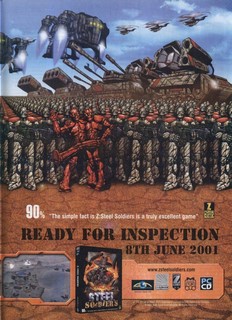
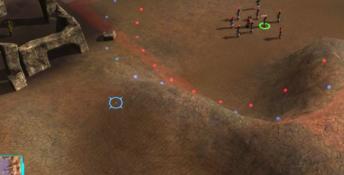
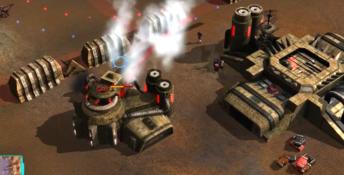

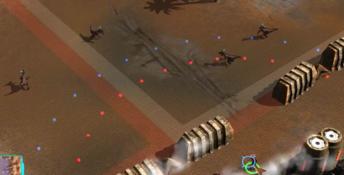
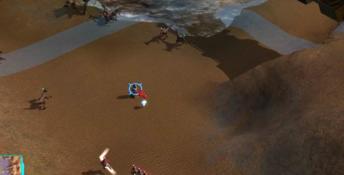

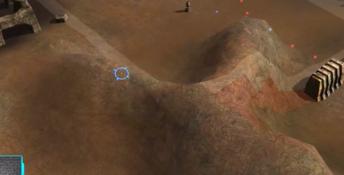
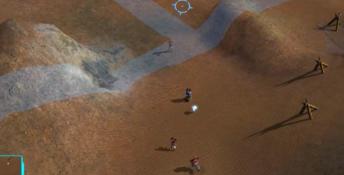

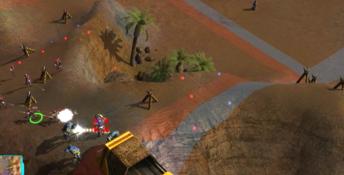

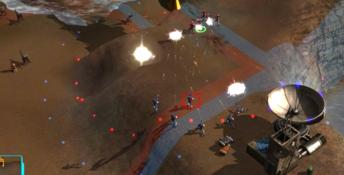
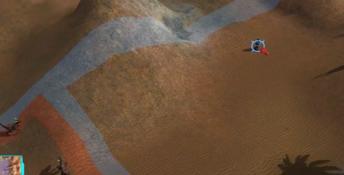



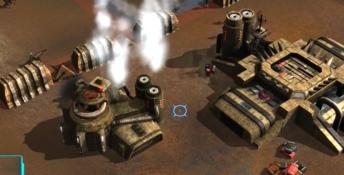

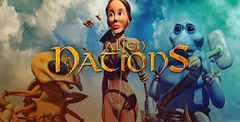 Alien Nations
Alien Nations Combat Mission
Combat Mission
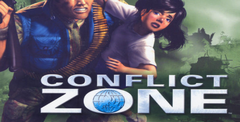 Conflict Zone
Conflict Zone Hostile Waters
Hostile Waters
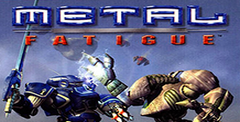 Metal Fatigue
Metal Fatigue
 Project Nomads
Project Nomads Sudden Strike
Sudden Strike
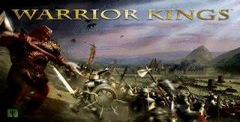 Warrior Kings
Warrior Kings